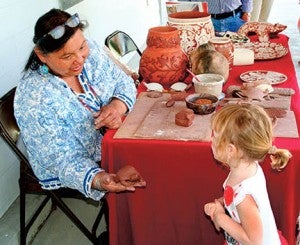History in the making
Published 9:41 am Tuesday, April 26, 2016
WINDSOR – Clay Swindell may have said it best:
“If you’ve found the Lost Colony, please let us know.”
That’s how Swindell, one of a trio of lecturers in addition to displays and crafts that were presented at the first Lost Colony Festival, summed it up at the Roanoke/Cashie River Center Saturday in Windsor.

Senora Lynch, a member of the Haliwa Saponi tribe, shows off a pottery turtle she has made to CarolJean Pierce of Jamesville during the Lost Colony Festival Saturday in Windsor. See page 3 of today’s edition for additional photos, as well as on the News-Herald’s Facebook page. | Staff Photo by Gene Motley
Swindell spoke on the topic of “How the Colony Wound up Here”, with here being Bertie County, one of several locales believed to be where the 117 colonists ended up after leaving Roanoke Island in Dare County.
In the late 16th century Sir Walter Raleigh, a wealthy English courtier and favorite of Queen Elizabeth I, sponsored expeditions to settle the Outer Banks and Chesapeake regions in the New World.
Captains of an early scouting trip in 1584 had identified Roanoke Island – off North Carolina’s coast – as a suitable place for the first English colony; and in 1585-86 Raleigh sent his first exploratory expedition. In 1587 the “Citte of Raleigh” was established on the island.
Move ahead now three years later when a British ship returned to the island to drop off supplies and the settlers were nowhere to be found. All that was left of what had been English life was a carving on a tree reading “CROATOAN,” which likely referred to the Croatoan Island 50 miles south in what is modern-day Hatteras.
Or, it could have meant 50 miles westward into the mainland and to the banks of Bertie County’s Salmon Creek and the Albemarle Sound!?!
Town of Windsor Tourism Director Billy Smithwick sponsored a lecture with Swindell and other members of the First Colony Foundation, a non-profit organization dedicated to conducting archaeological and historical research relating to the story of North Carolina and America’s beginnings, at the Windsor Community Building nearly a year ago. This year Smithwick wanted to expand it into an all-day affair with the emphasis on public education and interpretation.
“I’m really, really, pleased,” said Smithwick of the turnout. “The lecture room was overflowing; people are milling around at the exhibits with lots of questions and getting lots of good information.”
The festival also attracted several tribes of Native Americans, including the Haliwa Saponi of Warren County and the Cheroenhaka Nottoway of Franklin County VA.
“All these (Native Americans) are ‘river people’,” Smithwick said. “We’re pleased they could come down and join us with their crafts and exhibits, because it’s been well worth speaking with them. They give some idea of how the Indians used the river and how important the river was to the Indians.”
Another lecturer was with Dr. Randy Daniels, chairman of the Anthropology Department at East Carolina University in Greenville, speaking on the life of Native Americans in the 16th century.
“It was a hunting-gathering-fishing economy,” said Daniels. “And it’s great to see so many people interested in heritage, because we all share a common heritage and while they may not be related to Native American groups, or colonials, I think there’s a fascination about our past and that’s what makes us human.”
Heber Coltrain of Roanoke Outdoor Adventures led pontoon boat rides down river on the Cashie.
“The big presence in Bertie County was the Tuscarora, descendants of which still live in the Indian Woods area,” said Coltrain. “Later they moved north to join other nations.”
“The Cashie is one of the oldest, deepest, and cleanest rivers on the East Coast,” Coltrain continued. “People taking the tour have been interested in the types of wildlife, on land and in the water, used for food year round. They also want to hear about the steamers that came upriver to take out the tar, pitch, and turpentine to other parts of the state and the country. Every little community had a river landing. For those who love the outdoors and history in general this is a great place to visit.”
Displays included basket weaving, an authentic dug-out canoe, pottery of the 1500’s, arrowheads, and the “Ms. P”, a genuine replica of an early American colonial workboat.
Nick Luccketti, also with First Colony Foundation and the James River (VA) Institute for Archeology, closed the lectures with updates on excavations at ‘Site-X’.
It was Luccketti who directed a small team of archaeologists to Site X, located near present day Merry Hill, the focus of First Colony investigations on eastern North Carolina as the possible location of a colonial outpost. Luccketti says evidence continues to mount that this site deserves further, and more intense, archaeological investigation.
First Colony hopes to have a final report on their findings released sometime later during Summer 2016.
Part tragedy, part mystery, part historical curiosity, the fate of the Lost Colony continues to spark interest with its sense of intrigue; and that’s what organizers of this festival hope to capitalize upon.


